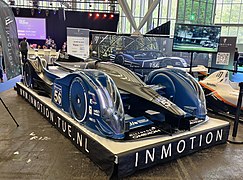|
InMotion
InMotion (also known as Automotive Technology InMotion) is a student team focused on electric racing and fast charging innovations. InMotion is based at the Automotive Campus in Helmond and is composed mostly of students from the Eindhoven University of Technology and Fontys University of Applied Sciences. Over the years, four different project race cars have been created. The Revolution, now recognized as the fastest-charging long-distance electric race car globally, was propelled to this status in July 2023 with the unveiling of the Next Generation Battery Pack by InMotion, enabling it to charge in just under 4 minutes. HistoryThe team was founded in 2012 by Albert Maas under the guidance of Maarten Steinbuch.[4] In 2017, the Fusion, the team’s first car, was built.[4] The Fusion is an electric formula car and holds the electric lap record in Circuit Zandvoort,[1] Circuit Zolder[2] and TT Circuit Assen.[3] After the Fusion, the team developed an endurance race car, the Vision. InMotion is now working on the Revolution, which is a Ginetta G58 (also known as LMP3 style), containing their Electric Refueling technology. The ultimate dream is to compete in the 24 Hours of Le Mans, in the Garage 56 class, in order to test the car and battery pack in the toughest conditions.[5] Currently, the team has around seventy students working on the current project car.[6] VehiclesIgnitionThe Ignition model was the first project race car designed and was powered by bio-ethanol before the team moved into electrification with the next model.[7] FusionThe InMotion team launched its first full electric racing car in 2016. The car was based on the former Formula Bio car has been built on a carbon fiber chassis. The full electric engine has a better power to weight ratio compared to a Formula E car.[8] The car made its track debut at Circuit Zandvoort during the 2016 Masters of Formula 3 event. Drivers Xavier Maassen and Jan Lammers gave the car a shakedown.[9] In 2017 USF2000 driver Rinus van Kalmthout did a straight line test at the Automotive Campus Helmond test track (part of the A270 motorway). During the year the team improved track records for electric cars at two tracks. Beitske Visser improved the record at Zandvoort.[10][11] Testdriver Maassen beat the track record for electric cars at Circuit Zolder, previously held by Bert Longin in a Tesla Roadster.[12] Currently, the Fusion is an electric formula car and holds the electric lap record in Circuit Zandvoort,[1] Circuit Zolder[2] and TT Circuit Assen.[3] VisionIn September 2018, the Vision was revealed to the world, unveiling the concept of the ultimate electric endurance racecar according to InMotion. This groundbreaking vehicle not only embodied their innovative design philosophy but also announced their new focus: fast charging. Termed 'Electric Refueling', this advancement addresses an issue hindering the widespread adoption of electric cars: long charging times. Their aim was to eliminate this barrier, making electric cars more enticing and accessible to the general public. In this car, mostly the aerodynamics was taken into account; it is almost 10 times as aerodynamically efficient as a current Formula 1 car.[5] [6] RevolutionThe Revolution is the current project race car designed to be ready to showcase the fast-charging technologies applied by the team. During the assembly phase of the Revolution in November 2020, InMotion achieved another significant milestone: an exceptionally rapid fast-charging time. Within just 12 minutes, the race car's state of charge (SoC) increases from 20% to 80%. After 2.5 years, the team successfully reduced charging time by 66%. In July 2023, InMotion unveiled the Next Generation Battery Pack, facilitating the Revolution's ability to charge in just under 4 minutes. As far as is known, this achievement positions the Revolution as the fastest-charging long-distance electric race car globally.[7][13] Gallery
References
External links |
||||||||||||||||||






